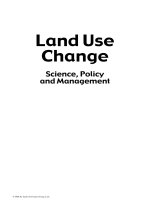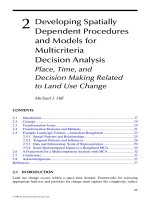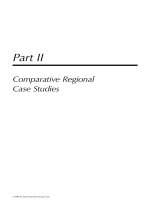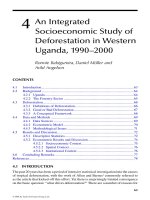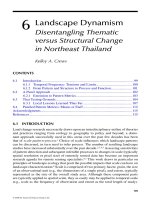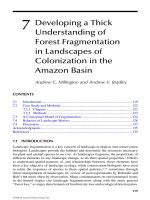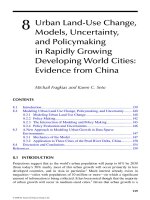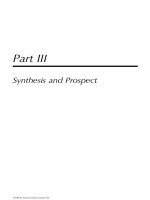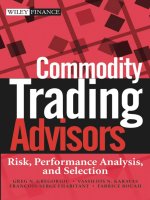Land Application of Sewage Sludge and Biosolids - Chapter 1 docx
Bạn đang xem bản rút gọn của tài liệu. Xem và tải ngay bản đầy đủ của tài liệu tại đây (266.59 KB, 21 trang )
LEWIS PUBLISHERS
A CRC Press Company
Boca Raton London New York Washington, D.C.
of
and
LAND APPLICATION
SEWAGE SLUDGE
BIOSOLIDS
Eliot Epstein, Ph.D.
This book contains information obtained from authentic and highly regarded sources. Reprinted material
is quoted with permission, and sources are indicated. A wide variety of references are listed. Reasonable
efforts have been made to publish reliable data and information, but the author and the publisher cannot
assume responsibility for the validity of all materials or for the consequences of their use.
Neither this book nor any part may be reproduced or transmitted in any form or by any means, electronic
or mechanical, including photocopying, microfilming, and recording, or by any information storage or
retrieval system, without prior permission in writing from the publisher.
The consent of CRC Press LLC does not extend to copying for general distribution, for promotion, for
creating new works, or for resale. Specific permission must be obtained in writing from CRC Press LLC
for such copying.
Direct all inquiries to CRC Press LLC, 2000 N.W. Corporate Blvd., Boca Raton, Florida 33431.
Trademark Notice:
Product or corporate names may be trademarks or registered trademarks, and are
used only for identification and explanation, without intent to infringe.
Visit the CRC Press Web site at www.crcpress.com
© 2003 by CRC Press LLC
Lewis Publishers is an imprint of CRC Press LLC
International Standard Book Number 1-56670-624-6
Library of Congress Card Number 2002073030
Printed in the United States of America 1 2 3 4 5 6 7 8 9 0
Printed on acid-free paper
Library of Congress Cataloging-in-Publication Data
Epstein, Eliot, 1929–
Land application of sewage sludge and biosolids / Eliot Epstein.
p. cm.
ISBN 1-56670-624-6 (alk. paper)
1. Land treatment of wastewater. 2. Sewage disposal in the
ground Environmental aspects. 3. Sewage sludge Management. I. Title.
TD774 .E64 2002
628.3
¢
8—dc21 2002073030
CIP
Preface
As indicated in Chapter 1 of this book, land application of sewage sludge and
biosolids has been practiced for centuries. Over the past 40 years, I have been
involved in various aspects of organic matter and soils. Since 1972, I have researched,
studied, and published on various aspects of biosolids management, concentrating
on composting and the public health aspects of land application. I have been an
active member on the Water Environment Federation Residuals Committee and The
U.S. Composting Council Board of Directors. In 1977, I published a book titled
The
Science of Composting
.
It was very difficult to write the present book because the literature on this subject
is enormous. I reviewed more than 4000 references during the year that it took me
to write it, and cited more than 570 references. The interest and concerns of scientists
throughout the world not only indicate the importance of the subject, but also show
the dedication to disseminating information related to health and the environment.
It is very evident that the majority of the scientific community think that the man-
agement and use of biosolids in a sound manner is proper and environmentally safe.
My objective in writing this book was to provide the reader with insights into
the scientific writings and findings. Those who are interested in more detail can
delve into the cited works to obtain more information.
One of the major aspects of land application of biosolids is the issue of risk to
humans, animals, plants and the environment. The two major categories of risk are
(1) voluntary and (2) imposed. People who smoke cigarettes do so voluntarily, even
though they are aware of the risk. The same applies to driving a car or flying. These
are all voluntary risks. However, we often do not have choices, but have a risk
imposed upon us. The placement of nuclear power plants near communities is such
an imposed risk. The most important issue related to imposed risks is how serious
or great they are. We do not live in a risk-free society. The risk and vulnerability
clearly impacted all of us on September 11, 2001. Consider the risk of using biosolids
on human health and the environment in light of the following:
• The risk from contaminated food by
E. coli
O157:H7, which has resulted in
numerous deaths and contamination of food by
Salmonella
sp. and other bacteria.
• The risk from contaminated water, which has resulted in many persons being ill,
as well as numerous deaths.
• The risk from bacteria and viruses when using home toilets (Gerba, C.P., C. Wallis,
and J.L. Melnick, 1975. Microbial hazards of household toilets: Droplet production
and the fate of residual organism.
Applied Microbiol
ogy 30(2):229-237).
• The risk of ingesting fish contaminated with mercury, as compared with ingesting
mercury from biosolids-contaminated food.
• The risk of indoor air pollution from volatile organic compounds in carpets, paints,
household cleaners, etc.
• The risk of bioaerosols when walking through the park or visiting a farm, as
compared with the potential risk from bioaerosols from an outdoor composting
facility.
• The risk of a Staphylococcus infection or infection by
Aspergillus fumigatus
in a
hospital.
©2003 CRC Press LLC
It is important to put the use of biosolids into the proper risk perspective.
Biosolids can be disposed of only in the soil, water or air. The greatest advantages
to land application are that we can control our activities and manage them. Once a
contaminant is in the water or air, it is very difficult to control it. Our biosolids
control and management practices need to be consistent with good scientific knowl-
edge and judgment. It is the duty of the scientist to seek out the truth and to provide
the engineer and biosolids manager with the knowledge and direction of how best
to protect the health of humans, animals, plants and the environment. I hope this
book will shed some light on the degree of potential risk from applying biosolids
to land.
I would like to repeat my quotation from Berth Damon cited in my earlier book.
It is also appropriate for land application of biosolids, as the organic matter will
eventually turn into humus.
To consider
humus
is to get a hint of the oneness of the universe. All flesh is grass,
in more than the figurative sense the prophet intended. During the long history of
this planet, weather has disintegrated rock, tiny lichens have made a speck of vegetable
mold, countless generations of short-lived weeds have waxed fat for summer, giant
forests have flourished for an aeon, and all in turn have died and given back to the
earth more goodness than they have taken from it. All have been composted into
humus. And the life of insects and of animals and of men which was sustained upon
the life of these plants and upon the life of other animals, all these creatures too have
enriched the surface of the earth with their excreta and finally with their bodies. All
in turn have been composted into humus.
©2003 CRC Press LLC
Acknowledgments
I am most grateful to Dr. Albert Page from the University of California, Riverside,
a well-recognized soil scientist who has written numerous articles and books on this
subject, who reviewed and commented on the chapters on heavy metals. Numerous
individuals have provided me with insight and knowledge over the years. Several
who coauthored articles with me include Drs. Rufus Chaney, Bob Dowdy, Terry
Logan, Chuck Henry, Pat Millner and John Walker. All have contributed to our
knowledge and understanding of the use and management of biosolids and organic
matter. I would also like to thank Laure MacGibbon, our administrative assistant at
Tetra Tech, Inc., for assisting me in editing this book.
My greatest thanks and appreciation go to my family. They have provided me
with inspiration, support and encouragement throughout the entire process. My wife,
Esther, deserves special thanks for the considerable time she spent proofreading the
manuscript, contacting firms for permission to use material, and many other tasks
throughout the process.
©2003 CRC Press LLC
Author
Eliot Epstein
is Chief Environmental Scientist for Tetra Tech, Inc. and an adjunct
professor of public health at Boston University School of Public Health at the School
of Medicine. He received his B.S. degree in Forestry from New York College of
Forestry at Syracuse University, an M.S. degree in Agronomy from the University
of Massachusetts, and a Ph.D. in soil physics from Purdue University. For 16 years
he was a research leader for the U.S. Department of Agriculture’s Agricultural
Research Service and an adjunct professor of soil physics at the University of Maine.
His research there concentrated on soil erosion and runoff and soil water relations
of plants.
In 1972, Dr. Epstein transferred to the USDA ARS research center in Beltsville,
Maryland, where he conducted research on the use of biosolids, and where, in 1975,
he researched and developed the aerated static pile method (ASP). In 1980, he
became president of E&A Environmental Consultants, Inc., a premier company in
composting and beneficial use of organic materials. In that capacity, he was the
principal-in-charge of numerous projects conducted by the staff located in Massa-
chusetts, North Carolina, and Washington State.
Dr. Epstein has more than 30 years of experience in biosolids composting, and
has managed or directed more than 400 composting projects in the United States,
Canada and Europe. He consulted on composting and biosolids management for the
US EPA, World Bank and United Nations. In 2001, Dr. Epstein and his staff joined
Tetra Tech, Inc., a leading company in water reuse, wastewater and beneficial use
of organic residues.
©2003 CRC Press LLC
Table of Contents
Chapter 1
Land Application of Biosolids: A Prospective
Introduction
Use and Disposal of Sewage Sludge and Biosolids
Systems for the Use or Disposal of Sewage Sludge and Biosolids
History of Land Application of Sewage Sludge and Biosolids
Wastewater Treatment and Biosolids Production
Conclusion
References
Chapter 2
Characteristics of Sewage Sludge and Biosolids
Introduction
Physical Properties
Chemical Properties
Trace Elements, Heavy Metals, and Micronutrients
Organic Compounds
Acidity (pH)
Plant Nutrients
Biological Properties
Microbiological
Organic Matter
Conclusion
References
Chapter 3
Plant Nutrients
Introduction
Nitrogen
Ammonification
Nitrification
Immobilization
Denitrification
Volatilization
Mineralization
Phosphorus
Potassium
Micronutrients
Conclusion
References
Chapter 4
Trace Elements: Heavy Metals and Micronutrients
Introduction
Sources of Trace Elements, Heavy Metals, and Micronutrients
in the Environment
Trace Elements in Biosolids
L1624_frame.book Page 9 Thursday, September 12, 2002 10:37 AM
©2003 CRC Press LLC
Trace Elements in Animals, Humans, Soils, and Plants
Arsenic (As)
Animals and Humans
Soils
Plants
Cadmium (Cd)
Animals and Humans
Soil
Plants
Chromium (Cr)
Animals and Humans
Soils
Plants
Copper (Cu)
Animals and Humans
Soils
Plants
Lead (Pb)
Animals and Humans
Soils
Plants
Mercury (Hg)
Animals and Humans
Soils
Plants
Molybdenum (Mo)
Animals and Humans
Soils
Plants
Nickel (Ni)
Animals and Humans
Soil
Plants
Selenium (Se)
Soil
Plants
Zinc (Zn)
Animals and Humans
Soil
Plants
Conclusion
References
Chapter 5
The Effect of Sewage Sludge and Biosolids on Uptake of Trace
Elements and Reactions in Soil
Introduction
L1624_frame.book Page 10 Thursday, September 12, 2002 10:37 AM
©2003 CRC Press LLC
Plant Uptake of Heavy Metals
Reactions and Movement in Soils
Conclusion
References
Chapter 6
Organic Chemicals
Introduction
Fate of Toxic Organic Compounds when Biosolids Are Land Applied
Volatilization
Photodecomposition
Degradation
Plant Uptake of Organic Compounds
Conclusion
References
Chapter 7
Pathogens in Wastewater and Biosolids
Introduction
Pathogens in Wastewater, Sludge, and Biosolids
Removal of Pathogens by Wastewater Treatment Processes
Effect of Biosolids Treatment
Aerobic Digestion
Anaerobic digestion
Composting
Heat Drying
Alkaline Stabilization
Conclusion
References
Chapter 8
Pathogens in Soils and on Plants
Introduction
Pathogens in Soils
Bacteria
Viruses
Parasites
Pathogens on Plants
Conclusion
References
Chapter 9
Land Application: Agricultural Crop Responses
Introduction
Agronomic Crops
Research Results Prior to 1970
Research Results 1970 to 2001
Forestry and Reclamation
Forestry
Reclamation
L1624_frame.book Page 11 Thursday, September 12, 2002 10:37 AM
©2003 CRC Press LLC
Conclusion
References
Chapter 10
Effect of Land Application of Biosolids on Animals
and Other Organisms
Introduction
Animals
Domestic
Wildlife
Microbes
Earthworms
Conclusion
References
Chapter 11
Regulations
Introduction
Concepts and Approaches to Regulations
United States
Method I
Method II
Class A Requirements
Process Requirements
Alternative 1—Thermally Treated Sewage
Sludge [(503.32(a)(3)]
Alternative 2—Sewage Sludge Treated in a High
pH–Temperature Process (Alkaline Treatment)
[503.329(a)(94)]
Alternative 3—Sewage Sludge Treated in Other Processes
[503.32(a)(5)]
Alternative 4—Sewage Sludge Treated in Unknown Processes
[503.31(a)(6)]
Alternative 5—Use of Process to Further Reduce Pathogens
(PFRP) [503.32(a)(7)]
Alternative 6—Use of a Process Equivalent to PFRP
[503.32(a)(8)]
Class B Requirements
Canada
Europe
Conclusion
References
L1624_frame.book Page 12 Thursday, September 12, 2002 10:37 AM
©2003 CRC Press LLC
CHAPTER
1
Land Application of Biosolids:
A Prospective
INTRODUCTION
The United States Environmental Protection Agency (USEPA) accepts the term
biosolid
for sewage sludge that is treated to meet the regulations in 40CFR503
(USEPA, 1994). Moreover, the term
sludge
is used for many different materials,
both inorganic and organic. A better term would be sewage biosolids, because it
indicates the biological nature of the residual and its origin. Many organic residuals,
e.g., paper mill sludges, are biological and could be classified as biosolids. In this
text, biosolids will be used to designate treated sewage sludge that meets USEPA
Class A or B. Raw sludge, e.g., primary, waste-activated, secondary sludge, and
those materials that do not meet the USEPA Class A or B will still be designated
as sewage sludge.
Biosolids are derived from the treatment of wastewater. The wastewater, prima-
rily derived from domestic sources, is treated at a publicly owned treatment works
(POTW). This wastewater will also contain discharges from commercial and indus-
trial enterprises. Many of these enterprises conduct pretreatment prior to discharging
wastes into the sewer system. As a result of pretreatment, which was enforced by
the Clean Water Act of 1974, biosolids have become less contaminated with trace
elements that include heavy metals and organic compounds.
The predominant wastewater treatment processes are primary and secondary
treatment. Tertiary treatment may be necessary before discharge of the clean effluent
is allowed into certain classes of water bodies. Both the nature of the domestic waste
and the secondary treatment, which is a biological treatment, result in sludge being
predominantly organic matter.
Solids in the wastewater stream are removed during primary and secondary
treatment. This sewage sludge, if it does not undergo further treatment, is often
referred to as raw sludge. It is usually incinerated, landfilled or further treated.
Further treatment may consist of digestion, composting or alkaline stabilization.
©2003 CRC Press LLC
After treatment, this material is called biosolids. Biosolids will contain inorganic
material, plant nutrients, trace elements, organic compounds, and pathogens. (More
data on characteristics of biosolids are presented in Chapter 2.) The organic nature
of biosolids, along with plant nutrients and several trace elements, which are micro-
nutrients for plants, makes it a valuable resource for land application. However, high
concentrations of several trace elements, toxic organic compounds, and pathogens
can preclude the beneficial use of biosolids.
USE AND DISPOSAL OF SEWAGE SLUDGE AND BIOSOLIDS
The USEPA in 1998 estimated that approximately 6,232,880 metric tons (tonnes)
or 6,856,168 dry tons are generated annually in the United States. In its September
1999 report entitled Biosolids: Generation, Use, and Disposal in the U.S., the agency
estimated that 7.1 million tons would be generated in 2000 and 8.2 million tons by
2010. The distributions for the most common methods of disposal or utilization are
shown in percentage terms in Figure 1.1. Distribution and marketing, which include
composting and heat drying, were estimated at approximately 3%. Ocean disposal
has been discontinued since 1992. Because disposal to landfills has been severely
curtailed in many states, land application has increased. Incineration is also decreas-
ing because many incinerators cannot meet the Clean Air Act regulations or the
USEPA 503 regulations.
In the United States there are vast differences in the way biosolids or sewage
sludge is utilized or disposed. These differences, compiled by Bastian (1997), show
that in New England and the Northeast less than 30% is land applied (Table 1.1).
A significant amount of biosolids from the Northeast is shipped out of state for
either land application or landfills. Nearly 90% of the biosolids produced in the
Northwest are land applied.
Table 1.2 compares the use and disposal of sludge and biosolids in 1989 and
1997. In that 9-year timeframe, land application that includes composting, heat
drying, and other products that are distributed or marketed increased by 12%,
landfilling and surface disposal decreased, incineration increased, and ocean dis-
posal ceased.
Figure 1.1
Use and disposal of sewage sludge and biosolids in the United States (USEPA,
1993).
LAND APPLICATION 54.0%
SURFACE DISPOSAL 18.0%
INCINERATION 19.0%
OTHER 9.0%
©2003 CRC Press LLC
Table 1.1
Biosolids/Sewage Sludge Utilized or Disposed by USEPA Regions in the United States
Region
Population
served by
POTWs
1
Total
biosolids/
sludge
production
(dmt/yr)
Percent used/disposed by:
Land
application
2
Surface
disposal
3
Incineration Other
I. New England 8,037,311 367,430 24 46 30 –
II. Northeast 21,726,101 605,046 30 14 23 33
4
III. Mid Atlantic 18,152,556 1,040,206
5,6
74 16 10 <1
IV. Southeast 24,510,111 1,050,325
5
57 30 12 1
V. North Central 35,587,804 1,705,316 51 2 30 17
7
VI. South Central 21,150,172 425,203
5
53 45 2 –
VII. Midwest 9,036,498 511,712
5
65.5 4 25.5 5
VIII. Rocky Mountains 6,262,873 111,880
5
68 29 0 3
7
IX. Southwest 30,432,899 819,050 51 36 4 9
7
X. Northwest 5,634,539 220,000 89 2 9 –
U.S. Totals 180,530,874 6,856,168
6
54 18 19 9
1
Based on 1992 Needs Survey Data (USEPA, 1993).
2
Includes all forms of land application practices, such as application of liquid, dewatered cake, dried, composted,
alkaline stabilized, or otherwise processed product to cropland, forests, reclamation sites, lawns, parkland, etc.; use
as organic fertilizer or soil amendment; use in potting mixes and the production of topsoil, etc. (including use as a
daily or final landfill cover as land application).
3
Includes co-landfilling with solid waste; monofilling; permanent disposal in piles or lagoons, etc.
4
Shipped out of state for use/disposal (mainly by land application and landfill).
5
Includes estimates based upon population served by POTWs and regional conditions.
6
Some estimates (based upon the number of households served by POTWs) of total production for Pennsylvania
would increase this number by 1,578,639 dmt/yr.
7
Long-term storage.
Source
: Bastian, 1997,
Eur. Water Pollut. Control
7(2): 62–78. With permission.
©2003 CRC Press LLC
At the same time, the quality of biosolids has improved. Examples of some reduc-
tions of heavy metals at several wastewater treatment plants are shown in Table 1.3.
(More detail on the characteristics of sludge and biosolids is provided in Chapter 2.)
Bastian (1997) reported that biosolids production in the United States has con-
stantly increased. Over the past 10 to 20 years, not only have there have been major
changes in sewage sludge/biosolids management practices, but also significant
changes in equipment (Bastian, 1997). These include:
1. Expanded use of mechanical dewatering equipment and polymers.
2. A shift from the use of multiple hearth incinerators to fluid bed incinerators.
3. Less long-term lagoon storage.
4. Less use of landfilling with municipal solid waste, but an increase in use as a
daily or final landfill cover material.
5. Increase in use of land application.
6. Increase in use of heat drying, pelletizing, composting, and alkaline stabilization
processing of biosolids to generate products.
7. A phase-out of ocean dumping.
8. More long-distance transport of biosolids to end use/disposal sites.
9. Increase in energy recovery from incinerators, landfills, and anaerobic digesters.
10. Increase of contracted-out biosolids management operations.
11. Increase in multiple biosolids use and disposal practices, especially by the large
authorities.
Bastian (1997) indicates that several factors influenced these trends in sewage
sludge/biosolids processing and use/disposal practices:
1. Dramatic increases in biosolids production.
2. Improvement in quality of biosolids as a result of industrial pretreatment.
3. Improvements in biosolids handling equipment and processing.
4. Improvement in biosolids management practices.
5. Increase in costs for urban land, labor, and energy.
6. A willingness of management agencies to pay dramatically higher prices for
biosolids processing, beneficial use, and disposal.
7. More information from research and development and monitoring activities.
8. Changes in regulatory policies and requirements.
9. Increase in public sensitivity on environmental and health issues and negative
public reactions to biosolids processing sites and disposal facilities.
Table 1.2 A Comparison of Sludge and Biosolids’ Use or Disposal
in The United States in 1989 and 1997
Use or Disposal 1989* 1997**
Land application & distribution and marketing 42 54
Landfill, monofill and surface disposal 24 18
Incineration 11 19
Ocean 3 0
Other 12 9
* USEPA analytical survey (USEPA, 1990).
** Bastian, 1997.
©2003 CRC Press LLC
More recent factors that are influencing biosolids management practices are land
application bans, incinerator air emissions, and odors from composting operations.
Matthews (1999) reported on management methods in Europe. Table 1.4 shows
his data. Disposal methods vary considerably in the different European countries.
Matthews indicates that sludge/biosolids production in the European Union will have
doubled from 1992 to 2002. Marine disposal will be discontinued, putting more
pressure on land-based methods of utilization and disposal. In Greece, for example,
90% of the biosolids was landfilled. On average in Europe, 36.4% of the biosolids
was used in agriculture; 41.6% were landfilled; and 10.9% was incinerated. The
remaining 11.19% was dumped into the ocean or surface waters, or used for other
purposes such forestry or recultivation.
SYSTEMS FOR THE USE OR DISPOSAL OF SEWAGE SLUDGE
AND BIOSOLIDS
There are several options for the disposal or utilization of biosolids:
• Direct land application
• Composting and land application
Table 1.3 Examples of Several POTWs Demonstrating Reductions in
Biosolids’ Heavy Metals
POTW (actual flow) Source Years
Reported Reductions
in Loadings to
Biosolids
Bowling Green, KY
(5 mgd)
Pocatello, ID
Albany, NY
(7 mgd)
1985–1988
1985–1988
1983–1987
Zn – 97%; Pb – 90%
Cr – 72%; Ni – 100%
Cd – 91%; Cu – 88%
Zn – 45%; Pb – 36%
Cr – 67%; Ni – 56%
Cd – 57%; Cu – 43%
Zn – 94%; Pb – 98%
Cr – 99%; Ni – 99%
Cd - <50%; Cu – 99%
Springfield, OH
(19.9 mgd)
Oswego, IL
(22.8 mgd)
Louisville and Jefferson
County, KY (97.9 mgd)
Metro Seattle, WA
(156 mgd)
1984–1989
1985–1990
1982–1989
1981–1989
Zn – 77%; Pb – 87%
Cr – 79%; Ni – 50%
Cd – 79%; Cu – 53%
Zn – 56%; Pb – 47%
Cr – 92%; Ni – 78%
Cd – 96%; Cu – 50%
Zn – 79%; Pb – 68%
Cr – 74%; Ni – 25%
Cd – 83%; Cu – 54%
Pb – 46%; Cd – 38%
Cu – 56%
Source
: Bastian, 1997,
Eur. Water Pollut. Control
7(2): 62–78. With permission.
©2003 CRC Press LLC
• Heat drying and land application
• Incineration
• Landfilling
• Dedicated land disposal
Direct land application can be beneficially used in agriculture, forestry, and land
reclamation. The biosolids can be applied in either in a liquid form with low solids
or as a semisolid following dewatering. Because of the nature of the material, in
that it contains a large amount of water, it is often applied within relatively short
distances. Exceptions include New York City, where dewatered, digested biosolids
are rail hauled and applied as far as Texas and Colorado. Similarly, cities in southern
California have some of their biosolids trucked to Arizona. Chicago Greater Met-
ropolitan District barged liquid biosolids to Fulton County, a distance of approxi-
mately 200 miles, and then applied the liquid biosolids to agricultural land.
Direct land application for beneficial use involves some form of partial stabili-
zation such as digestion or alkaline stabilization. Digestion results in USEPA 503
Class B biosolid whereas alkaline stabilization can result in a Class A or B product.
The USEPA 503 regulations allow for either a Class A or Class B to be applied to
land (see Chapter 12 for more information about regulations).
Application of biosolids for beneficial uses considers the crop requirement for
the plant nutrients as well as the accumulation of trace elements. When sewage
sludge or biosolids are land applied as a dedicated land disposal method, no crop
Table 1.4.
Biosolids Production and Disposal Methods in Europe
Country
Quantity
1000 dry
tonnes/
year Agriculture Landfill Incineration Sea
Other (e.g.,
recultivation,
forestry)
Percent
Austria 170 18 35 34 – 13
Belgium 59.2 29 55 15 – 1
Denmark 170.3 54 54 40.9 – 2
Finland 150 25 75 – – –
France 865.4 58 27 15 – –
Germany 2681.2 27 54 14 – 5
Greece 48.2 10 90 – – –
Ireland 36.7 12 45 – 35 8
Italy 816 33 55 2 – 10
Luxembourg 8 12 88 – – –
Netherlands 335 26 51 3 – 20
Norway 95 58 44 – – –
Portugal 25 11 29 – 2 58
*
Spain 350 50 35 5 10 –
Sweden 200 40 60 – – –
Switzerland 270 45 30 25 – –
UK 1107 44 8 7 30 11
Total 7387 36.4 41.6 10.9 5.19 6
*
Surface waters
Source:
Data from Matthews, 1999.
©2003 CRC Press LLC
is grown and the amounts applied are usually greater than when the biosolids are
beneficially used.
Composting and heat drying are forms of land application. These technologies
produce a USEPA 503 Class A product that provides for a wider range of uses.
Today, most of these products meet the “Exceptional Quality” criteria for trace
elements. The drier nature of these two materials provides for bagging and
shipping to greater distances. Bagged composted animal manure has been shipped
from California to Germany and heat-dried products are shipped from Massachu-
setts to Florida.
Biosolids compost is primarily used as a soil amendment and is valued for the
organic matter content (Epstein, 1997). Its primary use today is in the horticultural
field. However, recently farmers in several areas of the United States have been
using compost to improve their soil’s physical properties such as water holding
capacity and soil structure. The nitrogen content of compost is lower than heat-dried
biosolids. Therefore, larger quantities can be applied to improve the soil’s physical
properties. Heat-dried biosolids are considered as a fertilizer and applied at fertilizer
rates. They may be used as a supplement to other inorganic fertilizer material to
increase the plant nutrient content. Milorganite is an example of a heat-dried biosolid
product from the city of Milwaukee, Wisconsin. It is widely used as a fertilizer in
the turf industry.
HISTORY OF LAND APPLICATION OF SEWAGE SLUDGE
AND BIOSOLIDS
References to land application of wastes can be found in the Bible (Deuteronomy
23:13 and Judges 3:20). The Greek and Romans understood the benefits of basic
sanitation to society. In Ephesus, Turkey, steam-heated toilets were in place and
wastes were flushed into the Aegean Sea. The author, in a visit to Ephesus, noted
this continuous flushing system using heated marble toilets. Doxiadis (1973) also
indicated that domestic wastes were conveyed to land application areas. In the 16th
century, effluents were being used for crop production in Bunzlau, Germany. This
practice began in 1550 and continued for 300 years (De Turk, 1935).
Jewell and Seabrook (1979) cited Gerhard (1909), who indicated that the
earliest documented sewage farm or sewage irrigation system was in Bunzlau in
1531. In England, in 1859, a Royal Commission on Sewage Disposal recom-
mended the application of town sewage to land as a means of avoiding river
pollution (Webber and Hillard, 1974). Another early sewage farm was established
in Edinburgh, Scotland around 1860. Major cholera epidemics in London in the
mid-1800s that claimed more than 25,000 lives stimulated the treatment of sani-
tation facilities (Jewell and Seabrook, 1979). By 1876, 35 towns in Britain used
land treatment. Large sewage farms were established in Paris, France (1869) and
in Berlin, Germany (1874).
Between 1870 and 1880 there were 30 to 50 land application sites. Land appli-
cation was just beginning in the United States (Jewell and Seabrook, 1979). The
first sewage crop irrigation system in the United States was established in Augusta,
Maine in 1872. By 1900 there were more than 10 places in the United States using
©2003 CRC Press LLC
land treatment and by 1980 more than 4,000. Table 1.5 shows some selected land
applications systems in Europe and the United States.
Anderson (1959) stated that the use of sewage sludge as a fertilizer dates essen-
tially from 1927, when a large activated sludge treatment plant went into operation
for the city of Milwaukee, Wisconsin. Table 1.6 shows the utilization of biosolids
as fertilizer from 1930 to 1957 (Anderson, 1959). The author indicated that for
sanitary reasons, activated sludge must be heat-treated before it is sold as fertilizer.
He stated that digested biosolids should be heat-treated or incorporated into the soil
for several months before application on vegetables.
Table 1.5
Some Early Land Application Systems
Location
Date
started Type of System Area-ha Flow m
3
/d
International
Croydon-Bedlington, England 1860 Sewage farm 255 21,198
Paris, France 1869 Slow rate infiltration 6,475 299,050
Leamington, England 1870 Sewage farm 162 3,785
Berlin, Germany 1874 Sewage farm 27,519 —
Worclaw 1882 Sewage farm 809 105,992
Melbourne, Australia 1893 Slow rate infiltration 4,209 189,272
Overland flow 1,416 264,981
Braunschweig, Germany 1896 Sewage farm 4,452 60,567
Mexico City, Mexico 1900 Slow rate infiltration 45,360 215,770
United States
Calumet City, Michigan 1886 Rapid infiltration 4.86 4,543
Woodland, California 1889 Slow rate infiltration 97 15,899
Fresno, California 1891 Slow rate infiltration 1620 98,421
San Antonio, Texas 1895 Slow rate infiltration 1620 75,709
Vineland, New Jersey 1901 Rapid infiltration 5.67 3,028
Ely, Nevada 1908 Slow rate infiltration 567 5,678
Source
: Data from Fuller, 1983.
Table 1.6
Utilization of Biosolids as Fertilizer from 1930 to 1957
Year
Dried Activated Biosolids
Dried Digested Biosolids
As Separate
Material
As Mixed
Fertilizer
As Separate
Material
As Mixed
Fertilizer
1930 14,852 17,811 — —
1940 26,307 78,992 23,000 3,000
1945 29,261 61,306 30,274 5,791
1950 63,366 55,965 30,738 6,581
1953 69,494 — 36,719 —
1957 93,152 — 37,577 —
Source
: Adapted from Anderson, 1959.
©2003 CRC Press LLC
WASTEWATER TREATMENT AND BIOSOLIDS PRODUCTION
Wastewater treatment usually involves the following steps:
• Screening and grit removal
• Primary wastewater treatment
• Secondary wastewater treatment
• Tertiary (advanced) wastewater treatment
• Stabilization (biosolids production)
• Alkaline stabilization
• Anaerobic digestion
• Aerobic digestion
• Composting
• Heat drying and pelletizing
Table 1.7
A Summary of the Major Wastewater Processes
Wastewater Treatment Level
Types of Sewage Sludge or Biosolids
Produced
Screening and Grit Removal
Wastewater screening removes coarse
solids that can interfere with
mechanical equipment. Grit removal
separates heavy inorganic, sandlike
solids that would settle in channels and
interfere with the treatment processes.
Screening and grit are handled as a solid waste
and nearly always landfilled. This material is not
considered sewage sludge or biosolids and is not
governed by USEPA 40CFR503 regulations.
Primary Wastewater Treatment
Usually involves gravity sedimentation of
screened, degritted wastewater to
remove suspended solids prior to
secondary treatment.
Sewage sludge by primary wastewater treatment
usually contains 3%–7% solids; generally their
water content can be easily reduce by thickening
or dewatering.
Secondary Wastewater Treatment
Generally relies on biological treatment
(e.g., suspended growth or fixed growth
systems), in which microorganisms are
used to reduce biochemical oxygen
demand and remove suspended solids.
Secondary treatment is the minimum
treatment level required for POTWs
under the Clean Water Act.
Sewage sludge produced by secondary
wastewater treatment usually has a low solids
content (0.5% –2%) and is more difficult to
thicken and dewater than primary sludge.
Unstabilized solids can be landfilled or
incinerated. Stabilization can result in the
production of biosolids.
Tertiary (Advanced) Wastewater Treatment
Used at POTWs that require higher
effluent quality than that produced with
secondary treatment. Common types
of treatment include biological and
chemical precipitation processes to
remove nitrogen and phosphorus.
Lime, polymers, iron or aluminum salts used in
tertiary wastewater treatment produce sewage
sludge with varying water-absorbing
characteristics. Also, high-level lime precipitation
produces alkaline biosolids.
Source:
Based on USEPA, 1999.
©2003 CRC Press LLC
An extensive discussion of the stabilization processes is provided by Switzen-
baum et al., 1997. Other discussions can be found in several documents produced
by USEPA (USEPA, 1994; 1999). Table 1.7 summarizes some key features of the
stabilization processes that produce biosolids.
Table 1.8.
A Summary of the Stabilization Processes that Produce Biosolids
Stabilization Process USEPA 40CFR503 Classification and Use
Alkaline Stabilization
Use of lime or other alkaline materials,
such as cement kiln dust, lime kiln dust,
Portland cement and fly ash. Increase of
pH to reduce pathogens and achieve
vector attraction reduction.
The process can produce a Class A or Class
B. Major uses are in agriculture, reclamation,
slope stabilization, structural fill, and
municipal solid waste (MSW) landfills.
Anaerobic Digestion
Anaerobic digestion involves biologically
stabilizing biosolids in a closed vessel to
reduce the organic content, mass, odor,
and pathogens. During this process
methane is generated and can be used
as an energy source. Both mesophilic
temperatures (35
o
C, 95
o
F) and
thermophilic temperatures (55
o
C, 131
o
F)
are used.
The process produces either a Class B at
mesophilic temperatures or Class A at
thermophilic temperatures. The production of
Class B is more common. Principal uses are
in agriculture and forestry.
Aerobic Digestion
Aerobic digestion utilizes oxygen or air to
biologically stabilize biosolids in an open
or closed vessel or lagoon. The organic
matter is converted to carbon dioxide,
water, and nitrogen. Pathogens and odors
are reduced. High thermophilic
temperatures are recently being used.
Generally in most cases a Class B biosolids
is produced. High temperature systems can
produce a Class A product. The principal
uses are in agriculture.
Composting
Composting is the biological
decomposition of the organic matter.
Generally biosolids composting is done at
thermophilic temperatures (>55
o
C, 131
o
F)
in order to destroy pathogens. During
composting the odorous compounds are
reduced.
Composting produces a Class A product. Its
principal uses are horticultural, including
landscaping, nursery operations, turf, lawn
and sod production, agriculture, public works
department projects, highway beautification
and reclamation.
Heat Drying and Pelletizing
Heat drying involves using active or
passive dryers to remove water from
biosolids. It is used to destroy pathogens
and remove water, which reduces the
volume of material. In some cases heat-
dried products are formed into pellets.
Heat drying produces a Class A biosolids
product. It is primarily used in agriculture.
Other uses are in turf and sod production and
golf courses. Heat dried pellets are also
blended with other nitrogen, phosphorus, and
potassium chemicals to produce fertilizers.
©2003 CRC Press LLC
CONCLUSION
The advent of improved sanitation and wastewater treatment has resulted in the
production of sewage sludge and biosolids. Increased public concern for environ-
mental pollution of oceans, waterways, and the air has resulted in the increase in
beneficial use. The increase in beneficial use, especially land application (including
heat drying, composting, and alkaline stabilization), mandated that the quality of
biosolids be improved. Industrial pretreatment requirements resulted in very signif-
icant reduction of pollutants. There were dramatic increases in research on heavy
metals in the late 1970s, 1980s, and 1990s. This research allowed USEPA to pro-
mulgate risk-based regulations to protect public health and the environment.
The production of biosolids through various stabilization processes allows waste-
water residuals to be beneficially used. The majority of the biosolids produced in
the United States is land applied either directly to agriculture or further processed
through composting or heat drying for use in agriculture or horticulture.
REFERENCES
Anderson, M.S., 1959, Fertilizing characteristics of sewage sludge,
Sewage Ind. Wastes,
31:
678–682.
Bastian, R.K., 1997, The biosolids (sludge) management treatment beneficial use, and disposal
situation in the USA,
Eur. Water Pollut. Control
7(2): 62–78.
DeTurk, E.E., 1935, Adaptability of sewage sludge as a fertilizer,
Sewage Works J
. 7 (4): 597–610.
Doxiadis, C.A., 1973, Ancient Greek settlements: Third report,
Ekistics
35(11).
Epstein, E. 1997,
The Science of Composting
, Technomic, Lancaster, PA.
Fuller, W.H., 1983, Soil injection of sewage sludge for crop production, Dept. Soils, Water
and Eng., College of Agric., U. of Arizona, Tech. Bull. 250, Tucson.
Gerhard, W.P., 1909,
Sanitation and Sanitary Engineering
, self-published, New York.
Jewell, W.J. and B.L. Seabrook, 1979, A history of land application as a treatment alternative.
U.S. Environmental Protection Agency, Technical Report EPA 430/9-79-012, Wash-
ington, D.C.
Matthews, P., 1999, Sewage sludge treatment and biosolids management in Europe, Conf. on
Sewage Sludge Treatment and Disposal in Madrid.
Switzenbaum, M.S., L.H. Moss, E. Epstein, A.B. Pincince and J.F. Donovan. 1997. Defining
biosolids stability,
J. Environ. Eng
. 123(12): 1178–1184.
USEPA, 1990, National Sewage Sludge Survey: Availability of information and data and
anticipated impacts on proposed regulations; Proposed Rule, U.S. Environmental
Protection Agency,
Fed. Reg
. 54(23): 47210–47283, Washington, D.C.
USEPA, 1993, Needs survey report to Congress, U.S. Environmental Protection Agency,
Office of Water, EPA 832-R-93-002, Washington, D.C.
USEPA, 1994, A plain English guide to the EPA Part 503 Biosolids rule, Rep. No. EPA/832/R-
93/003, U.S. Environmental Protection Agency, Office of Wastewater Management,
Washington, D.C.
USEPA, 1999, Biosolids generation in the United States, U.S. Environmental Protection
Agency, Municipal and Industrial Solid Waste Division, Office of Solid Waste,
EPA530-R-99-009, Washington, D.C.
Webber, L.R. and B.C. Hillard, 1974, Agricultural use of sludge, 120-142. In
Proc. Conf.
Program Abatement Munic. Pollut. Provis., Canada, Agreement Great Lakes Water
Qual.,
University of Guelph, ON.
©2003 CRC Press LLC
